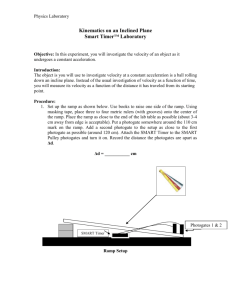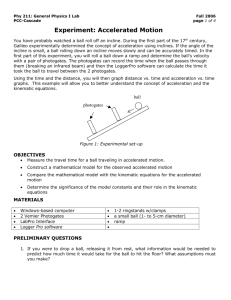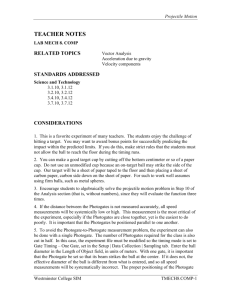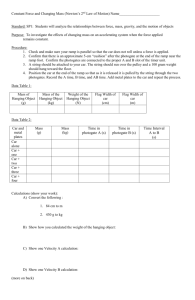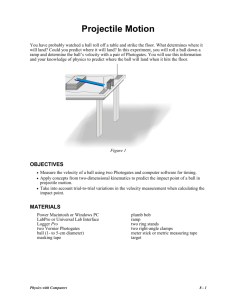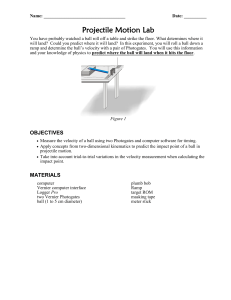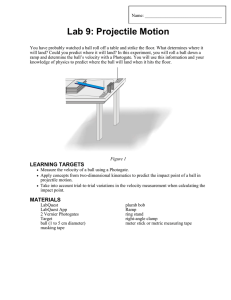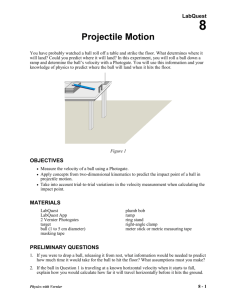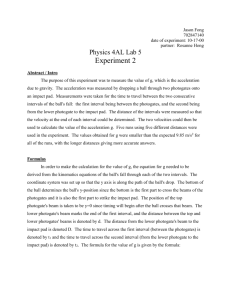Phsc&101_Lab4 Projectile Motion.doc
advertisement
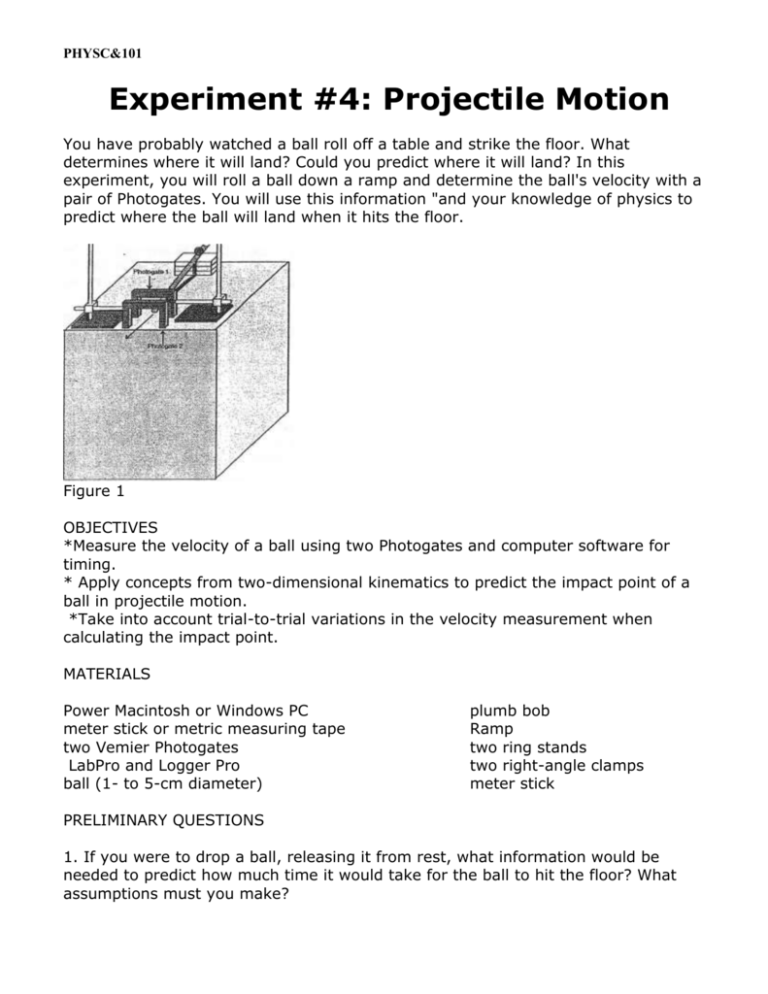
PHYSC&101 Experiment #4: Projectile Motion You have probably watched a ball roll off a table and strike the floor. What determines where it will land? Could you predict where it will land? In this experiment, you will roll a ball down a ramp and determine the ball's velocity with a pair of Photogates. You will use this information "and your knowledge of physics to predict where the ball will land when it hits the floor. Figure 1 OBJECTIVES *Measure the velocity of a ball using two Photogates and computer software for timing. * Apply concepts from two-dimensional kinematics to predict the impact point of a ball in projectile motion. *Take into account trial-to-trial variations in the velocity measurement when calculating the impact point. MATERIALS Power Macintosh or Windows PC meter stick or metric measuring tape two Vemier Photogates LabPro and Logger Pro ball (1- to 5-cm diameter) plumb bob Ramp two ring stands two right-angle clamps meter stick PRELIMINARY QUESTIONS 1. If you were to drop a ball, releasing it from rest, what information would be needed to predict how much time it would take for the ball to hit the floor? What assumptions must you make? PHYSC&101 2. If the ball in Question I is traveling at a known horizontal velocity when it starts to fall, explain how would you calculate how far it will travel before it hits the ground. 3. A pair of computer-interfaced Photo gates can be used to accurately measure the time interval for an object to break the beam of one Photogate and then another. If you wanted to know the velocity of the object, what additional information would you need? PROCEDURE. I. Set up a low ramp made of angle molding on a table so that a ball can roll down the ramp, across a short section of table, and off the table edge as shown in Figure I. 2. Position the Photogates so the ball rolls through each of the Photogates while rolling on the horizontal table surface (but not on the ramp). Approximately center the detection line of each Photogate on the middle of the ball. Connect Photogate I to the Dig/Sonic port I of the LabPro and Photogate 2 to the Dig/Sonic Port 2 . To prevent accidental movement of the Photogates, use tape to secure the ringstands in place. 3. Mark a starting position on the ramp so that you can repeatedly roll the ball from the same place. Roll the ball down the ramp through each Photogate and off the table. Catch the ball as soon as it leaves the table. Note: Do not let the ball hit the floor during these trials or during the following velocity measurements. Make sure that the ban does not strike the sides of the Photogates. Reposition the Photogates if necessary. 4. Prepare the computer for data collection by opening "Exp 08" from the Physics with Computers experiment files of Logger Pro. A data table and two graphs are displayed; one graph will show the time required for the ban to pass through the Photogates for each trial and the other will display the velocity of the object for each trial. 5. You must enter the distance between Photogates in order for Logger Pro to calculate the velocity. The program will divide this distance by the time interval it measures to get the velocity. Carefully measure the distance from the beam of Photogate I to the beam of Photogate 2. (It may be easier to measure from the leading edge of Photogate 1 to the leading edge of Photogate 2.) To successfully predict the impact point, you must enter an accurate measurement. Enter the distance into Logger Pro by double clicking on the "velocity" column and replacing the default setting 0.1 with your measurement 6. Click Collect. Check to see that the Photogates are responding properly by moving your finger through Photogate I and then Photogate 2. Logger Pro will plot a time interval value for each instance you run your finger through Photogate I or PHYSC&101 Photogate 2. Click Stop, then click Collect again, to clear the trial data and prepare for data collection. 7. Roll the ball from the end of the ramp, through both Photogates, and catch the ball immediately after it leaves the table. Repeat nine times. After the last trial, click. Stop to end data collection. Record the velocity for each trial number in the data table. 8. Inspect your velocity data. Did you get the same value every time? Determine the average, maximum and minimum values by clicking once on the velocity vs. time graph and then clicking the Statistics button. What one value would be most representative of all ten measurements? 9. Carefully measure the distance from the table top to the floor and record it as the table height H in the data table. Use a plumb bob to locate the point on the floor just beneath the point where the ball will leave the table. Mark this point with tape; it will serve as your floor origin. 10. Use the vertical distance H to calculate the time the ball was in the air. The vertical motion is a free fall H=1/2*g*t2 Solve for t and enter the value below t=____________ 11. Now we look at the horizontal distance X traveled during this time . We know that the horizontal motion is uniform and the velocity of the horizontal motion was measured with the photogates. V=_________ We can now calculate the horizontal distance X X=v*t X=_______________ Mark your predicted impact point on the floor with tape and position a target at the predicted impact point. Be sure the impact point is along the line of the track. 12. After your instructor gives you permission, release the ball from the marked starting point, and let the ball roll off the table and onto the floor. Mark the point of PHYSC&101 impact with tape. Measure the distance from the floor origin to the actual impact and enter the distance in the data table. DATA TABLE Trial Velocitv (m/s) 1 2 3 4 5 6 7 8 9 10 Average velocity Table height Predicted impact point Actual impact point distance m/s m m , m ANALYSIS 1. Should you expect any numerical prediction" based on experimental measurements to be exact? Explain. 2. Was your actual impact point inside the target? If so, your prediction was successful. 3. Did you account for air resistance in your prediction? If so, how? If not, how would air resistance change the distance the ball flies? PHYSC&101
